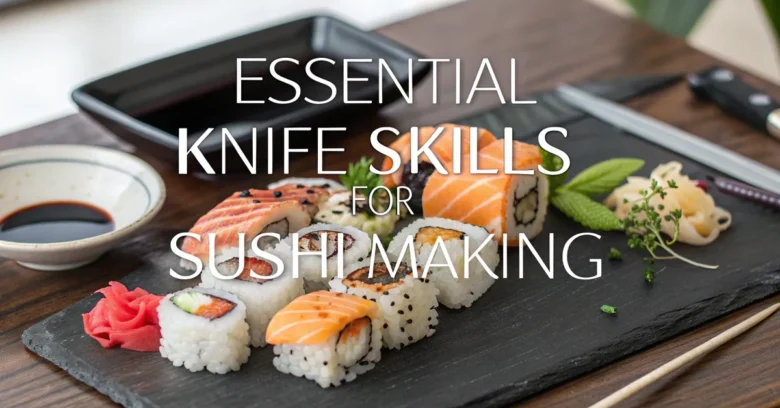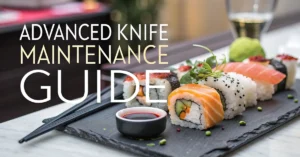Sushi, a culinary art form steeped in tradition, is more than just assembling rice and fish. It’s a delicate dance between flavor, texture, and presentation—a dance where knife skills take center stage. Many are drawn to the beauty and precision of sushi making. However, they soon realize it needs dedicated knife skills, and it can be a barrier to entry. But do not worry, learning how to cut like a sushi chef isn’t just for professionals.
This article will show you the essential knife skills you need to master. You will learn the basics and understand how each cut affects the final product. This knowledge will help you improve and make sushi confidently. Let’s begin this journey and transform your sushi-making skills!
Essential Knives for Sushi Making
Before diving into the cuts, let’s explore the knives that make it all possible. A good knife is more than just a tool, it is an extension of the sushi chef. A proper knife helps make clean cuts and reduces fish damage. Here are a few must-haves for any aspiring sushi chef:
- Yanagiba: This long, slender knife is the undisputed king of slicing fish. Its length allows for smooth, uninterrupted cuts, crucial for preserving the texture and appearance of the fish. A good yanagiba makes neat, single strokes and has a sharp edge.
- Deba: This thick, robust knife is designed for breaking down whole fish. Its weight and sturdy construction allow you to effortlessly cut through bones and cartilage. The deba can also be used in filleting and cleaning fish.
- Usuba: Primarily a vegetable knife, the usuba is characterized by its thin, rectangular blade. It excels at creating intricate vegetable garnishes and precise cuts. If you enjoy adding creative veggie components to your sushi, then this knife is essential.
- Santoku: A general-purpose Japanese knife, the santoku can be used for various tasks, including slicing fish, chopping vegetables, and mincing herbs. It’s a versatile option if you are just starting and do not want to invest in several specialized knives.
- Petty Knife: This small utility knife is perfect for smaller tasks like peeling shrimp, trimming fish, and other delicate jobs that the other bigger knives cannot do.
Caring for Your Knives
Your knives are your most prized tools. Caring for them will keep them in good condition for years to come. Follow these tips to make sure that they last:
- Sharpen Regularly: A sharp knife is a safe knife. Dull knives require more force, increasing the risk of slips and accidents. Use a whetstone to sharpen your knives regularly.
- Wash by Hand: Dishwashers can damage your knives. The high heat and harsh detergents can dull the blades and corrode the handles. Wash your knives by hand with warm, soapy water and dry them immediately.
- Store Properly: Store your knives in a knife block, on a magnetic strip, or in individual sheaths. This will prevent them from banging against other utensils and dulling their edges.
- Use the Right Cutting Board: Avoid using glass, marble, or ceramic cutting boards, as these can quickly dull your knives. Opt for wooden or high-quality plastic cutting boards instead.
Essential Knife Skills: Mastering the Cuts
Now that you have your knives in order, let’s get into the cuts. Each cut serves a specific purpose in sushi making, affecting the texture, presentation, and flavor of the final product. Here are the essential knife skills that every sushi chef should know:
Hira-zukuri: The Basic Slice
The hira-zukuri is the most basic slice, and it is a great place to start when learning the basics. It’s a rectangular cut, which is often used for nigiri and sashimi. Its simple shape makes it easy to handle and showcase the fish’s natural beauty. Here is how you can master this skill:
- Prepare the Fish: Start with a block of fish. Make sure it’s chilled but not frozen. This will help you to create clean cuts without tearing the flesh.
- Position the Knife: Hold your yanagiba at a slight angle to the fish. Start the cut near the heel of the knife, using the full length of the blade.
- Slice Smoothly: Use a single, smooth motion to slice through the fish. Apply gentle pressure and let the knife do the work. Avoid sawing back and forth, which can damage the fish.
- Control the Thickness: For nigiri, aim for slices about ¼ inch thick. For sashimi, you may want to make them slightly thicker, about ⅜ inch, to highlight the texture and taste.
- Practice Makes Perfect: Focus on your knife skills so that each slice is uniform. This will help you enhance the presentation.
Sogi-giri: The Angled Cut
The sogi-giri is an angled cut that adds elegance and visual appeal to sushi. It’s used to make thin, wide slices, perfect for draping over sushi rolls or garnishing plates. Here’s how to execute the sogi-giri effectively:
- Angle the Knife: Position the knife at a steep angle, approximately 45 degrees, to the fish.
- Slice Thinly: Use a long, sweeping motion to slice thinly through the fish. The goal is to create a wide, delicate slice.
- Maintain Consistency: Keep the angle consistent throughout the cut to ensure each slice is uniform.
- Versatile Application: Use sogi-giri slices to wrap sushi rolls, adding a layer of flavor and visual interest. They are also great for garnishing plates, providing an elegant touch.
Usu-zukuri: The Paper-Thin Slice
The usu-zukuri is a paper-thin slice that showcases the chef’s precision and skill. It’s often used for delicate fish like flounder or snapper, allowing the subtle flavors to shine through. Here’s how to achieve this delicate cut:
- Sharp Knife is Key: Make sure that your yanagiba is perfectly sharp. A dull knife will tear the fish, making a clean cut impossible.
- Stabilize the Fish: Place the fish on a stable surface and use your non-dominant hand to hold it firmly in place.
- Slice with Precision: Use a very light touch to slice through the fish, almost as if you are shaving it. The goal is to create a slice so thin that it is translucent.
- Presentation Matters: Arrange the usu-zukuri slices artfully on a plate, allowing the light to pass through them. This highlights their delicate texture and enhances the visual appeal.
Kaku-giri: The Cubed Cut
The kaku-giri is a cubed cut used for adding texture and substance to sushi rolls and dishes. It provides a different mouthfeel than sliced fish, making it a valuable technique to master. Here’s how to create perfect kaku-giri:
- Slice into Strips: First, slice the fish into uniform strips, similar to hira-zukuri but slightly thicker.
- Cut into Cubes: Stack the strips together and cut them into small, even cubes. Aim for cubes about ½ inch in size.
- Consistent Size: Make sure that the cubes are uniform in size to maintain a consistent texture in your sushi.
- Ideal for Rolls: Use kaku-giri as a filling for sushi rolls, adding a hearty, satisfying element. It can also be used in chirashi bowls or as a garnish.
Tanzaku-giri: The Rectangular Cut
The tanzaku-giri is a rectangular cut used primarily for vegetables. It adds a clean, geometric element to sushi and is perfect for ingredients like cucumber and avocado. Here’s how to execute tanzaku-giri with precision:
- Prepare the Vegetable: Start with a vegetable that has been peeled and trimmed. For example, a cucumber should be peeled and cut into manageable lengths.
- Slice into Planks: Cut the vegetable into thin, rectangular planks. Aim for planks about ¼ inch thick.
- Cut into Rectangles: Stack the planks together and cut them into uniform rectangles. The size of the rectangles will depend on your preference and the specific dish.
- Neat and Uniform: Focus on making each rectangle neat and uniform in size. This will enhance the presentation of your sushi.
Sasagaki: The Shaved Cut
The sasagaki is a shaved cut used primarily for burdock root (gobo). It creates thin, delicate shavings that add a unique texture and earthy flavor to sushi. Here’s how to achieve sasagaki effectively:
- Prepare the Burdock Root: Start with a length of burdock root that has been scrubbed clean.
- Hold at an Angle: Hold the burdock root at a slight angle over a bowl of water. This will prevent the shavings from oxidizing.
- Shave with a Knife: Use your knife to shave thin, delicate pieces from the burdock root. Rotate the root as you shave to create even shavings.
- Soak in Water: As you shave the burdock root, let the shavings fall into the bowl of water. This will keep them crisp and prevent them from discoloring.
Advanced Techniques and Tips
Now that you have mastered the basic cuts, here are a few advanced techniques and tips to elevate your sushi-making skills:
- Knife Angle and Pressure: The angle at which you hold your knife and the amount of pressure you apply can significantly affect the outcome of your cuts. Experiment with different angles and pressures to find what works best for you.
- Fish Selection: Different types of fish require different cutting techniques. Fatty fish like salmon and tuna can be sliced more easily with a gentle touch, while leaner fish like snapper require a sharper knife and more precise cuts.
- Temperature Control: Keep your fish chilled but not frozen. The ideal temperature is around 30-32°F (-1-0°C). This will help you to create clean cuts without tearing the flesh.
- Practice Regularly: Like any skill, mastering knife skills requires practice. Set aside time to practice your cuts regularly, even if it’s just for a few minutes each day.
Common Mistakes to Avoid
Even experienced sushi chefs make mistakes. Knowing what these mistakes are can help you learn from them and avoid them:
- Using a Dull Knife: A dull knife is not only inefficient but also dangerous. It requires more force, increasing the risk of slips and accidents. Make sure your knives are always sharp.
- Sawing Motion: Avoid using a sawing motion when slicing fish. This can damage the flesh and create ragged edges. Instead, use a single, smooth motion.
- Applying Too Much Pressure: Applying too much pressure can crush the fish and ruin its texture. Use a light touch and let the knife do the work.
- Neglecting Knife Maintenance: Neglecting knife maintenance can lead to dull blades, corroded handles, and other problems. Take care of your knives and they will take care of you.
Perfecting Your Presentation
Presentation is a key aspect of sushi. The way you arrange your sushi can enhance the dining experience and showcase your skills as a chef. Here are a few tips for perfecting your presentation:
- Color and Contrast: Use a variety of colors and textures to create visual interest. Combine different types of fish, vegetables, and garnishes to make your sushi visually appealing.
- Arrangement: Pay attention to the arrangement of your sushi. Arrange your nigiri, sashimi, and rolls in an attractive and balanced way.
- Garnishes: Use garnishes to add a finishing touch to your sushi. Fresh herbs, edible flowers, and microgreens can add color, texture, and flavor.
- Plating: Choose plates that complement your sushi. Simple, minimalist plates can showcase the beauty of your sushi, while more ornate plates can add a touch of elegance.
From Beginner to Expert: The Path to Mastery
Mastering sushi knife skills is a journey, not a destination. It takes time, practice, and dedication to develop the skills needed to cut like a sushi chef. You can accelerate learning with the following:
- Start with the Basics: Focus on mastering the basic cuts before moving on to more advanced techniques.
- Seek Guidance: Take a sushi-making class or work with an experienced sushi chef. A mentor can provide valuable feedback and guidance.
- Experiment: Don’t be afraid to experiment with different types of fish, vegetables, and garnishes. The more you experiment, the more you will learn.
- Be Patient: Mastering knife skills takes time and practice. Be patient with yourself and celebrate your progress along the way.
Should You Invest Time into Learning Knife Skills?
Knife skills are essential in sushi making. They influence the fish’s texture, presentation, and overall quality. While it takes effort to master these techniques, they’re an investment in your sushi-making journey. The skills will help you improve your dishes and get more enjoyment out of the process. So get your knives ready, and start today!



